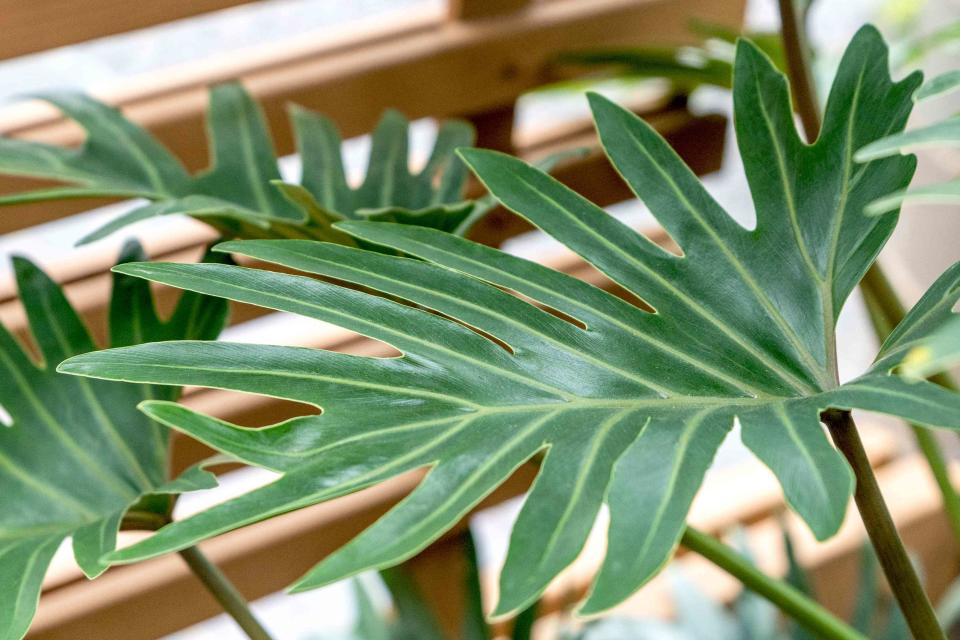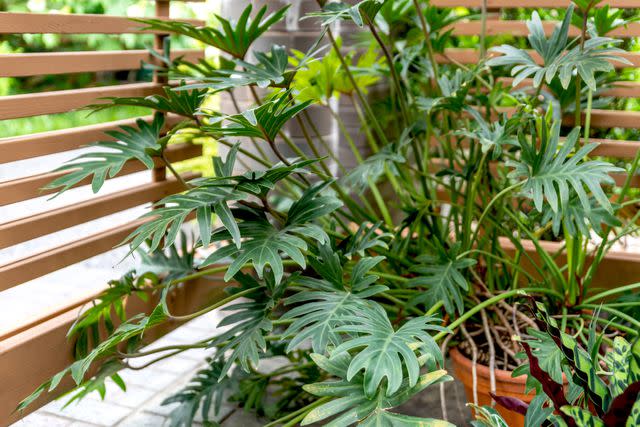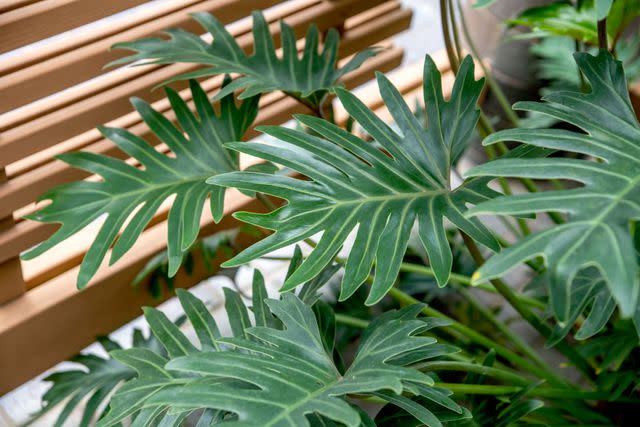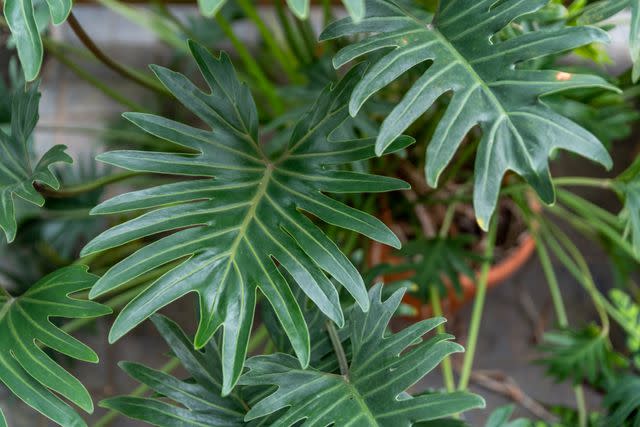How To Grow And Care For Philodendron Outdoors
If you love philodendron as a houseplant, you’ll be thrilled to know it grows outside in the South.

Southern Living/Adrienne Legault
This favorite houseplant has a secret identity: Some varieties grow as a garden perennial in the Tropical South. Philodendron is a fast-growing and nearly indestructible garden plant with beautiful leathery, glossy leaves. Once established, this plant might even dazzle with a bloom that resembles that of calla (Zantedeschia).
Philodendrons fall into two main classes: arborescent and vining. Arborescent philodendrons are relatively hardy. These large, shrub-size plants with big leaves and sturdy, self-supporting trunks. They can be grown indoors but need more space than most houseplants. These philodendrons grow outdoors in the Coastal and Tropical South (USDA Zone 9-11). As landscape plants, they like partial sun. In intense light, they need shade at midday (they can take considerable shade). Use them for tropical effects or as massive silhouettes against walls or glass. They stun in large containers and give a lush tropical look when planted near swimming pools.
Vining and self-heading philodendron includes tender plants of two different habits. They can grow outdoors in the Tropical South (USDA Zone 10-11) where they require partial or full shade. Outdoor philodendrons have interesting leaf shapes and sizes. The self-heading types form short, broad plants with leaves radiating out from a central point. Vining types do not climb; rather, they must be tied to or leaned against a support until they eventually shape themselves to it. The support can be almost anything, but certain water-absorbent columns—sections of tree fern stem, wire and sphagnum “totem poles,” slabs of bark—serve especially well, since they can be kept moist.
Plant Attributes
Common Name | Philodendron |
Botanical Name | Philodendron spp. |
Family | Araceae |
Plant Type | Perennial |
Mature Size | 6ft tall, 6 ft. wide |
Sun Exposure | Partial |
Soil Type | Rich, loose, well-drained |
Soil pH | Acidic |
Hardiness Zones | 11-12 (USDA) |
Native Area | South America, Central America |
Toxicity | Toxic to cats, dogs, and horses |

Southern Living/Adrienne Legault
Philodendron Care
Whether grown in containers or open ground, all philodendrons need rich, loose, well-drained soil. This plant does not love southern exposure and hot afternoon sun, so plant where it will receive morning sunlight and afternoon shade. If you grow perennial philodendron outdoors in containers, use highly organic soil or a professional soil mix from your greenhouse. Give philodendrons consistent moisture, but don’t let them sit in water. They don’t like soggy roots.
Light
Provide morning light and a shady afternoon cover where the plant can thrive in the humidity and temperatures without burning its leaves.
Soil
Philodendron does well in highly organic soil. Whether you plant them in the ground or in pots, use soil that is rich, loose, and drains well.
Water
Philodendron grow well in the Coastal and Tropical South, where humidity is high, but so are the temperatures. Be sure to provide consistent moisture to the ground or to your garden pots so that the plants will grow well.
Temperature and Humidity
In Zone 10–11 (USDA), the environment is hot and humid. These are conditions that cannot be controlled, and that is why philodendron is a good plant choice here. It thrives in the conditions that naturally occur in this part of the country, says Gary Bachman, PhD horticulturist at Mississippi State University.
Fertilizer
Bachman recommends a dose of a commercial fertilizer such as Miracle-Gro twice a year, and recommends following package instructions.

Southern Living/Adrienne Legault
Types of Philodendron
Thaumatophyllum bipinnatifidum. Arborescent. Treelike shrub to 4–10 ft. high and 6–10 ft. wide, typically with a single upright trunk that leans with age. Deeply cut leaves to 3 ft. long, on equally long stalks. ‘Hope’ is a compact shrub to 4 ft. high and wide and is reported to be hardier than the species.
P. domesticum. Vining. Often sold as P. ‘Hastatum’. Grows to 10–20 ft. high, with arrow-shaped, bright green leaves to 2 ft. long and 1 ft. wide.
P. erubescens. It grows to 10–60 ft. high, with foot-long, heart-shaped, deep green leaves with colorful undersides. Subject to leaf spot in overly warm, moist conditions. Several selections and hybrids are available; they are more resistant to leaf spots and are more compact. ‘Royal Queen’ has bright red new growth; mature leaves are dark green and heavily tinged with red. ‘Pink Princess’ has shiny black to deep burgundy leaves splashed and speckled with white and pink. Best color in bright light.
P. hybrids. ‘Lynette’ is self-heading to 1 ft. high, 2 ft. wide. Makes a tight cluster of foot-long, broad, bright green leaves that are strongly patterned by deeply sunken veins. Good tabletop plant. ‘Xanadu’ is self-heading and grows 3 ft. high and 5 ft. wide with large, drooping, glossy, green, deeply lobed leaves. ‘Autumn’ is self-heading, grows 2 ft. high and wide with colorful leaves that emerge coppery red then go through shades of red, orange, and yellow before maturing to shiny green. ‘Cobra’ is a climber with oval leaves variegated and spotted with white.
P. martianum. Self-heading. To 2 ft. tall, 3–4 ft. wide. Leathery, lance-shaped, dark green leaves grow to 11⁄2 ft. long and 6–8 in. wide; each leaf has a broad mid-rib and a swollen-looking, spongy, deeply channeled leafstalk to 15 in. long. Makes a nice coarse-leafed ground cover.
P. melanochrysum. BLACK- GOLD PHILODENDRON. Vining. To 10–20 ft. high, with velvety, lance- shaped greenish black leaves to 3 ft. long, 1 ft. wide. Midribs and lateral veins are pale green. The new leaves are heart shaped and have a coppery tinge.
P. scandens. HEART-LEAF PHILODENDRON. Vining. Among the most common philodendrons. Can reach 50 ft. Deep green, heart-shaped leaves; juvenile leaves are 4–6 in. long, while mature ones can grow to1 ft. long. P. s. micans has velvety young leaves; mature leaves are smooth. P. s. oxycardium (often sold as P. oxycardium or P. cordatum) has glossy leaves throughout its life. Juvenile forms of both are most popular; they are grown on tree trunks, in hanging baskets and window boxes, as houseplants. Indoors, train them on string or wire for a variety of decorative effects; or grow on moisture-retentive columns.
P. wendlandii. Self-heading. To 1 ft. high, 2 ft. wide. Compact clusters of 12 or more deep green, foot-long, broadly lance-shaped leaves on short, broad stalks. Indoors, this species is useful where a tough, compact foliage plant is needed.
P. williamsii. Arborescent. Arrow-shaped, glossy, deep green leaves to 21⁄2 ft. long and 1 ft. wide. Leafstalks almost as long as leaves.

Southern Living/Adrienne Legault
Pruning
There is no need to prune philodendron to maintain the health of the plant, but if lower leaves start to brown and look unhealthy, you can prune them to improve its appearance.
Potting and Repotting Philodendron
Because it is no simple chore to repot a large philodendron, it is best to plant this perennial plant in a large pot from the outset and maintain the plant once it matures.
Overwintering
The temperatures can fall below freezing in Zone 9–11 (USDA) once in a while, but there is no reason to move the plant. Drape a frost blanket or sheet over the plant to help it ride out those cold dips.
For more Southern Living news, make sure to sign up for our newsletter!
Read the original article on Southern Living.

